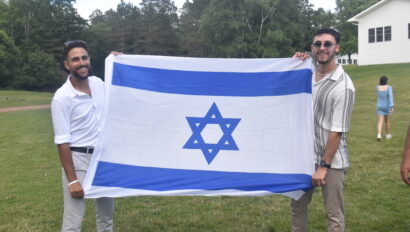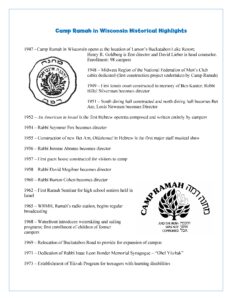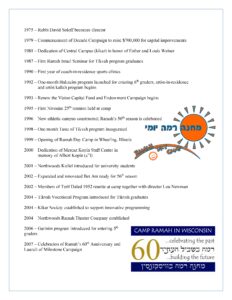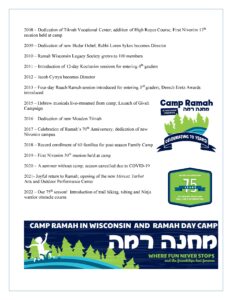(Note to reader: In general, I try to write in this space about the magic and power of Camp Ramah in Wisconsin and Ramah Day Camp in Chicagoland. This week I offer these words of Torah not about Ramah but as a proud alumnus and steward of our institution in the spirit, I believe, of the individual – the American and the Jew – of whom my counselors, teachers, mentors, and predecessors would be proud. As a dear confidante from camp reminded me earlier this week, the weekly Torah reading magically speaks to us every year. This week, of record cases of COVID-19 throughout America, of an election that has painfully reminded us how fractured we are as a country, of questions about the present and future of the American Experiment, of fears – however remote – for the physical safety of our fellow citizens, it is Parashat Vayeira that speaks to us. –JC)
Survival and Hope: Reflections on Parashat Vayeira
by Jacob Cytryn, Executive Director
The magnetic pull of Parashat Vayeira draws us to its final narrative: עקדת יצחק (akeidat Yitzchak), the binding of Isaac. Arguably, this is the most challenging ethical and theological story the Torah presents us, especially for the modern reader. The story of God instructing Abraham to take his cherished son into the wilderness and sacrifice him demands us to question God’s motivations and Abraham’s willingness. We are also left to ponder its ramifications: what is this story meant to teach us? In general, classical Jewish sources utilize the akeidah as the example par excellence of Abraham’s faith in God. Unlike other stories in Abraham’s life, the akeidah presents no hesitation, only unyielding fealty. Many other interpretations exist, and all leave us with two unanswerable questions: How do we believe in a God who would ask this? And how do we tie our lineage back to a parent who would do it?
I have no magical answers to these questions either. The role of the akeidah in the Torah – its didactic purpose – is, perhaps, more clearly discernable by focusing our attention on a different character. Isaac’s near death occurs under circumstances that are, at face value, exotic and unique; but his experience – vulnerability, fear of death, and an awareness of powerlessness – is a universal characteristic of the human condition. If we scratch a little at the surface, the role that Abraham and God play in Isaac’s experience is also not so unique: throughout history leaders, with intentions good and bad, have made decisions that have resulted in death or misery for the human beings they were charged with protecting and, in the ancient world and our own, people have died awaiting God’s rescue.
We who live in the greatest era of human history, especially those of us living in the industrialized West, may have forgotten the universality of Isaac’s experience because we have, in general, been spared the scourges of previous generations. This list is enumerated in a short, oft-overlooked addition to the Musaf service on festivals, which includes “pestilence, warfare, famine, captivity, destruction, iniquity, assimilation, plaque, misfortune, every disease, every stumbling-block, every contention, every type of disorder, every evil decree and groundless hatred.” We retain the painful challenges of personal loss but the horror and impact of mass destruction is rare. As I write this Primo Levi’s haunting, accusatory, and damning poem at the beginning of his memoir Survival in Auschwitz echoes in my head: “You who live safe in your warm houses, you who find warm food and friendly faces when you return home. Consider if this is a man … who knows no peace, who fights for a crust of bread, who dies by a yes or no.” Isaac’s story – living or dying on the head of a pin, at the whims of a brutal human world and the unforgiving and inscrutable ways of nature – was once universal, as it still is for many around the globe, was for the victims and survivors of the Holocaust, for some veterans of our armed forces, and more. And, as the last nine months have reminded us, that story all-too-easily becomes all of our story. We live today not just aware of the risks to ourselves and our loved ones but also with a small taste of the fear and anxiety previous generations could never escape.
To read the akeidah through Isaac’s eyes is to speak to the human condition, our vulnerability and the close interactions with death that must have been much more common, even in the relative good times, in the world in which it was written. And our public reading of it – annually as the weather begins to turn in both the climate of the Mediterranean and Middle East (where the weekly Torah readings were established) and all the more so in Europe, as well as in the heightened moment of Rosh Hashanah – connect the akeidah to two other essential aspects of the human condition: survival and hope.
In focusing on Isaac’s vulnerability the story demystifies the fear and trauma of daily life and, by definition, those of us who listen to the story have survived. Successful survival is accompanied by the great pain, even in our mundane and safe world, and all the more so in previous eras of civilization. My grandmother of blessed memory, Helen Cytryn (ז”ל), lived to be 92. She was born shortly after the flu pandemic of 1918-1920, survived scarlet fever in a world that was on the cusp of discovering antibiotics, was trained as a nurse for World War II but the war ended before she – or my grandfather, a doctor – could be deployed. She survived all that in her first twenty-five years. She also sat shivah no less than ten times, for her parents who died three weeks apart, for the seven (of eight) siblings she outlived, and for her beloved husband of sixty-plus years. She mourned enumerable other siblings-in-law, aunts, uncles, dear friends, and colleagues. She lived to hold her first great-grandchild, named for her husband. Who wouldn’t want to live to ninety-two, in full possession of their mental faculties, engaged in the world around them, with the resources to support themselves? How lucky was she? And how much pain did she endure?
Vulnerability. Fear. Pain. Survival. Hope. The akeidah represents one of two foreshadowing interactions Abraham has with the area that would eventually be called Jerusalem. The first, in last week’s parashah, involves an encounter with Melchizedek (literally: king of righteousness), who ruled over עיר-שלם (ir-shalem; city of peace). The second is the situation of the akeidah on הר המוריה (har hamoriah), which becomes the site of the Temple.
James Carroll, the brilliant writer on religion, wrote a book on Jerusalem tracing its resonance in Western culture through the millennia. In a book filled with discussions of violence and pain, the most moving is a detailed and compelling description of the role the idea of Jerusalem played in the creation and sustenance of our United States. The Pilgrims, religious exiles, saw themselves fleeing to a “new Jerusalem.” They built cities, many with Biblical names – Bethlehem and Efrata, Pennsylvania, come to mind – and also, in many states, called Salem, as in JeruSalem. The United States was, and is, imagined as a “City on a Hill,” and Jerusalem imagery is rife in Lincoln’s writings about saving the Union. If memory serves, Carroll ends his narrative about the US (the book was published in 2011) with imagery drawn from Reagan’s presidential campaigns, harking back to our aspirational potential as a nation.
At some point we will look back on 2020 from a place, God-willing, of more stability and less fear. Hopefully that is a place where we remember our vulnerability and have begun to heal it, through additional innovations in medical technology and a re-assessment of our public health infrastructure; through a renewed sense of civic identity, compromise, and an ability to truly hear our fellow citizens through what feel today like impassable obstacles. At that time, may we remember the feelings many of us have right now, feelings that tie us to our ancestors and to each other. And may we recall that we have done what Jews, and humanity in general, have done for millennia: we have survived. And we have been audacious enough to hope for more, a hope rooted in survival and memory. That should be the lesson of the akeidah.







